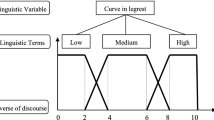Abstract
In this paper, we first introduce the definition of three-value cutting tensors of intuitionistic fuzzy tensors. Secondly, we discuss some fundamental properties by the definition of the three-value cutting tensors and relationships between elements and discuss the application of three-value cutting tensors in evaluating engineering projects. Finally, we investigate decomposition of intuitionistic fuzzy tensors by three-value cutting tensors under max–min compositional operations. Our numerical examples show the feasibility of the presented decomposition methods.
Similar content being viewed by others
References
Atanassov T (1983) Intuitionistic fuzzy sets. VII ITKR’S Session, Sofia
Atanassov T (1986) Intuitionistic fuzzy sets. Fuzzy Sets Syst 20(1):87–96
Atanassov KT (1999) Intuitionistic fuzzy sets. Springer, Heidelberg
Chen L, Lu LZ (2016) Algorithms for finding oscillation period of fuzzy tensors. Front Artif Intell Appl 293:51–57
Chen L, Lu LZ (2018) Convergence algorithms of fuzzy tensors. J Intell Fuzzy Syst 34:1769–1775
Chen L, Chen Z (2019) Decomposition theorem of fuzzy tensors and its applications. J Intell Fuzzy Syst 36:575–581
Chen L (2020) Decomposition theorem of intuitionistic fuzzy tensors. Comput Appl Math. https://doi.org/10.1007/s40314-019-1000-8
Harshman RA (1970) Foundations of the PARAFAC procedure: models and conditions for an “explanatory” multi-model factor analysis. UCLA working papers in phonetics 16, pp 1–84
Hitchcock FL (1927a) The expression of a tensor or a polyadic as a sum of products. J Math Phys 6:164–189
Hitchcock FL (1927b) Multiple invariants and generalized rank of p-way matrix or tensor. J Math Phys 7:39–79
Kolda TG, Bader BW (2009) Tensor decomposition and applications. SIAM Rev 51:455–500
Lathauwer LDE, Moor BDE, Vandwalle J (2000) A multilinear singular value decomposition. SIAM J Matrix Anal Appl 21:1253–1278
Lee HY, Jeong NG (2005) Canonical form of a transitive intuitionistic fuzzy matrices. Honam Math J 27(4):543–550
Li CD, Yi JQ, Wang HK (2018) Interval data driven construction of shadwed sets with application to llinguistic word medelling. Inf Sci. https://doi.org/10.1016/j.ins.2018.11.018
Li CD, Gao JL, Yi JQ, Zhang GQ (2018) Analysis and design of functionally weighed single-input-rule-modules connected fuzzy inference systems. IEEE Trans Fuzzy Syst 26:56–71
Lim LH (2005) Singular values and eigenvalues of tensors: a variational approach. In: Proceedings of the IEEE internatinal workshop on computation advances in multi-tensor adaptive processing, vol 1, pp 129–132
Murugadas P, Lalitha K (2016) Decomposition of an intuitionistic fuzzy matrix using implication operators. Ann Fuzzy Math Inform 11(1):11–18
Muthuraji T, Sriram S, Murugadas P (2016) Decomposition of intuitionistic fuzzy matrices. Fuzzy Inf Eng 8:345–354
Muthuraji T, Sriram S (2017) Representation and decomposition of intuitionistic fuzzy matrix using some \((\alpha, \acute{\alpha })\) cuts. Appl Appl Math 12(1):241–258
Oseledets IV, Savostianov DV, Tyrtyshnikov EE (2008) Tucker dimensionality reduction of three-dimensional arrays in linear time. SIAM J Matrix Anal Appl 30(3):939–956
Oseledets IV (2011) Tensor-train decomposition. SIAM J Sci Comput 33(5):2295–2317
Oseledets IV, Tyrtyshnikov EE (2009) Breaking the curse of demensionality or how to use svd in many demensions. SIAM J Sci Comput 31(5):3744–3759
Qi LQ (2005) Eigenvalues of a real supersymmetric tensor. J Symb Comput 40:1302–1324
Tucker LR (1966) Some mathematical notes on three-mode factor analysis. Psychometrika 31:279–311
Xu ZS (2007) Intuitionistic fuzzy aggregation operators. IEEE Trans Fuzzy Syst 15(6):1179–1187
Yuan XH, Li HX, Sun KB (2011) The cut sets, decomposition theorem and representation theorem on intuitionistic fuzzy sets and interval valued fuzzy sets. Sci China Inf Sci 54(1):91–110
Zadeh LA (1965) Fuzzy sets. Inf Control 8:338–353
Acknowledgements
The work was supported by the Doctor Foundation of Shandong Jianzhu University(X19046Z) and Taishan Scholar Project of Shandong Province (TSQN201812092) and National Natural Science Foundation of China (Grant No.11671105).
Author information
Authors and Affiliations
Corresponding author
Ethics declarations
Conflict of interest
The authors declare that there are no conflict of interest regarding the publication of this paper.
Ethical approval
This article does not contain any studies with human participants or animals performed by any of the authors.
Additional information
Communicated by V. Loia.
Publisher's Note
Springer Nature remains neutral with regard to jurisdictional claims in published maps and institutional affiliations.
Rights and permissions
About this article
Cite this article
Chen, L. Three-value cutting tensors of intuitionistic fuzzy tensors. Soft Comput 24, 18953–18958 (2020). https://doi.org/10.1007/s00500-020-05125-x
Published:
Issue Date:
DOI: https://doi.org/10.1007/s00500-020-05125-x




